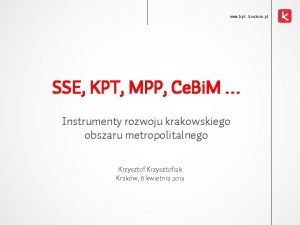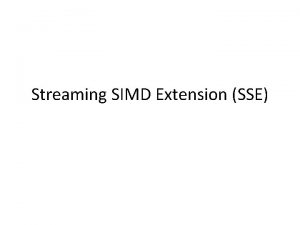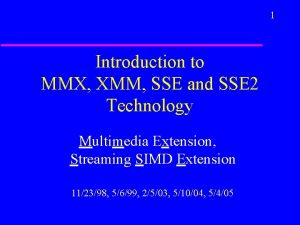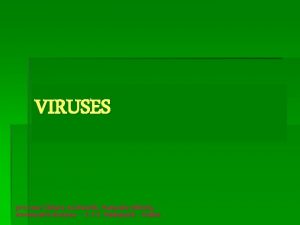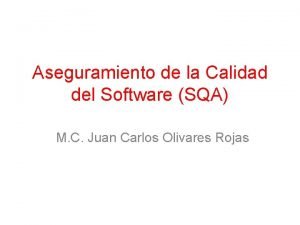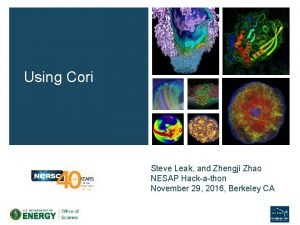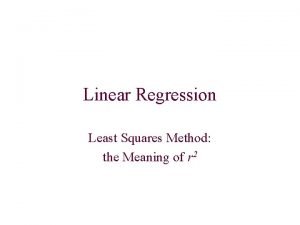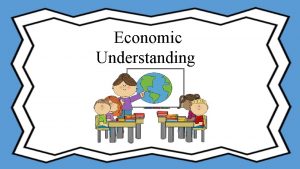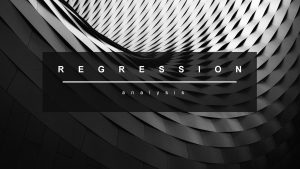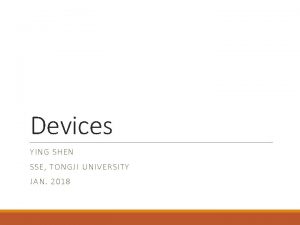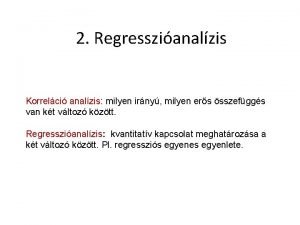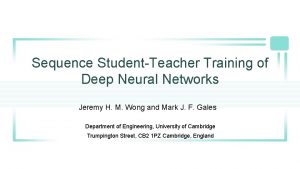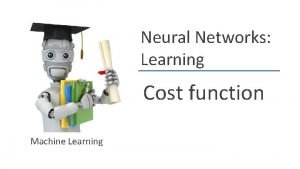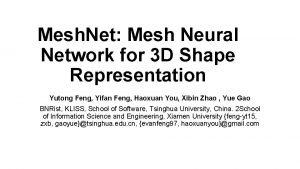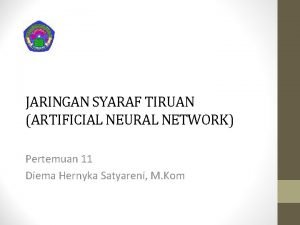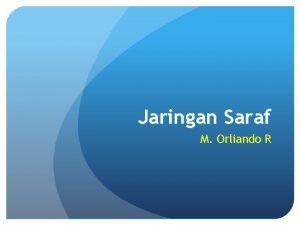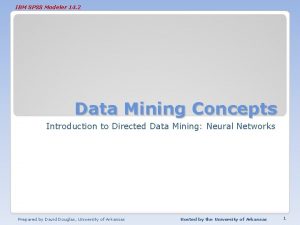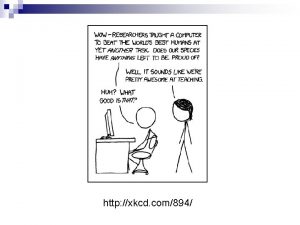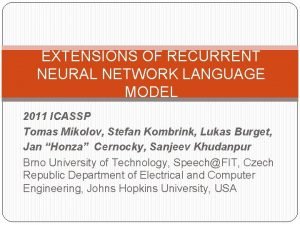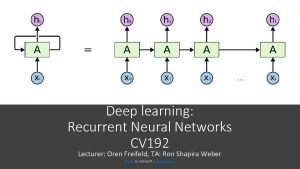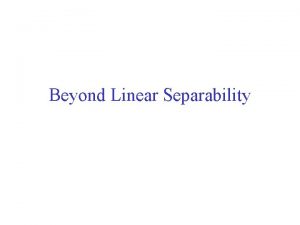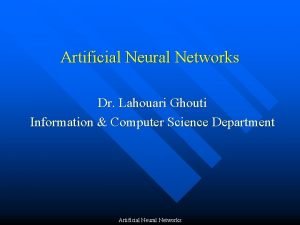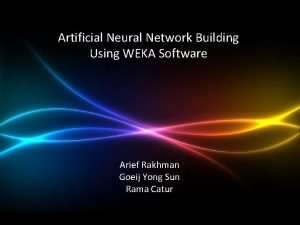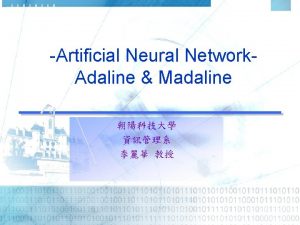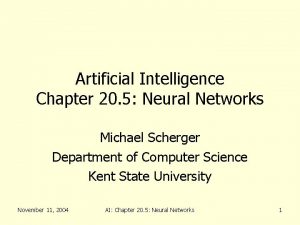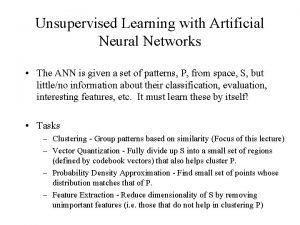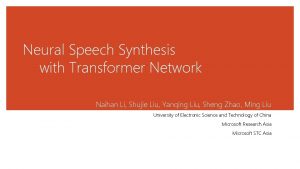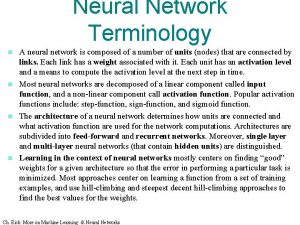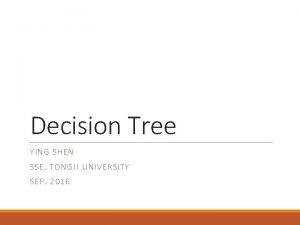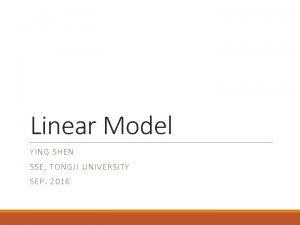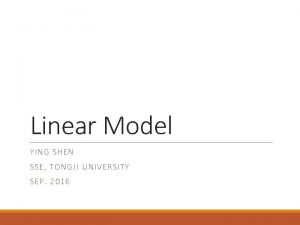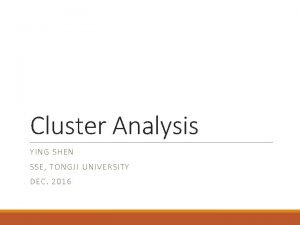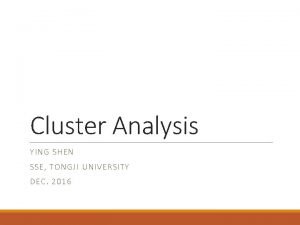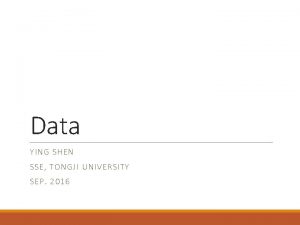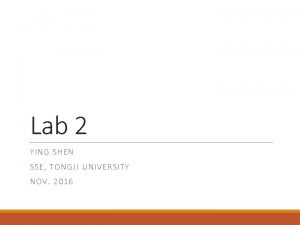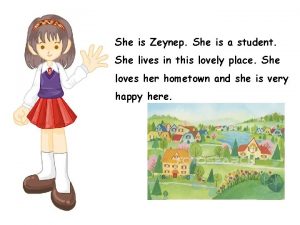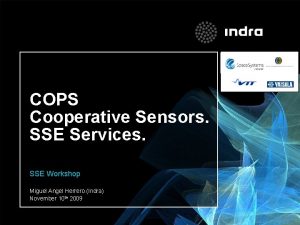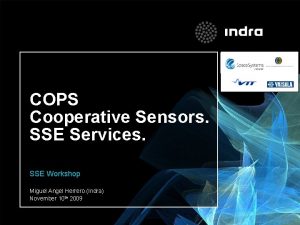Neural Network YI NG SHE N SSE TON








































- Slides: 40

Neural Network YI NG SHE N SSE, TON GJI UNIVERSITY DEC. 2016

Neural Network The study of artificial neural networks was inspired by attempts to simulate biological neural systems. The human brain consists primarily of nerve cells called neurons. They are linked together with other neurons via strands of fiber called axons. Axons are used to transmit nerve impulses from one neuron to another whenever the neurons are stimulated. 11/28/2020 PTTERN RECOGNITION page 2

Neural Network A neuron is connected to the axons of other neurons via dendrites, which are extensions from the cell body of the neuron. The contact point between a dendrite and an axon is called a synapse. The human brain learns by changing the strength of the synaptic connection between neurons upon repeated stimulation by the same impulse. 11/28/2020 PTTERN RECOGNITION page 3

Neural Network A neural network consists of a large number of simple, interacting nodes (artificial neurons). Knowledge is represented by the strength of connections between these nodes. Knowledge is acquired by adjusting the connections through a process of learning. All the neurons process their inputs simultaneously and independently. These systems tend to degrade gracefully due to this distributed representation. 11/28/2020 PTTERN RECOGNITION page 4

Artificial neuron The unit of computation in neural networks is the artificial neuron. An artificial neuron consists of ◦ ◦ Input signals A set of real-valued weights An activation level A threshold function 11/28/2020 PTTERN RECOGNITION page 5

Artificial neuron 11/28/2020 PTTERN RECOGNITION page 6

Artificial neuron 11/28/2020 PTTERN RECOGNITION page 7

Artificial neuron 11/28/2020 PTTERN RECOGNITION page 8

Example An artificial neuron can be used to compute the logic AND function. The neuron has three inputs ◦ x and y are the original inputs. ◦ The third is the bias input which has a constant value of +1. The input data and bias have weights of +1, and – 2 respectively. 11/28/2020 PTTERN RECOGNITION page 9

Example 11/28/2020 PTTERN RECOGNITION page 10

Example The neuron computes the values of x+y-2. If this value is less than 0, it returns – 1, otherwise a 1. The logical OR function can be similarly computed by changing the bias weight to -1 11/28/2020 PTTERN RECOGNITION page 11

Example 11/28/2020 PTTERN RECOGNITION page 12

Perceptron 11/28/2020 PTTERN RECOGNITION page 13

Perceptron The action of the rule can be summarized as follows: ◦ If the desired output and actual output values are equal, do nothing. ◦ If the neuron output is – 1 and should be 1 ◦ Increment the i-th weight by 2 cxi. ◦ If the neuron output is 1 and should be – 1 ◦ Decrement the i-th weight by 2 cxi. 11/28/2020 PTTERN RECOGNITION page 14

Perceptron The weights should not be changed too drastically because they are adjusted only for the current training example. Otherwise, the adjustments made in earlier iterations will be undone. 11/28/2020 PTTERN RECOGNITION page 15

Perceptron The step size c is a parameter whose value is between 0 and 1. It can be used to control the amount of adjustments made in each iteration. If c is close to 0, then the new weight is mostly influenced by the value of the old weight. If c is close to 1, then the new weight is sensitive to the amount of adjustment performed in the current iteration. 11/28/2020 PTTERN RECOGNITION page 16

Perceptron In some cases, an adaptive c value can be used ◦ Initially, c is moderately large during the first few iterations. ◦ It then gradually decreases in subsequent iterations. 11/28/2020 PTTERN RECOGNITION page 17

Example A set of patterns are to be classified in a 2 -D space. The first two columns of the table list the 2 -D coordinates of the patterns. The third column represents the classification, +1 or – 1. The patterns are linearly separable, i. e. , they can be completely separated by a hyperplane. 11/28/2020 PTTERN RECOGNITION page 18

Example 11/28/2020 PTTERN RECOGNITION page 19

Example 11/28/2020 PTTERN RECOGNITION page 20

Exclusive-OR Perceptron cannot solve those problems where the patterns are not linearly separable An example of this is the exclusive-OR problem. Multilayer networks are required for solving such kinds of problems. 11/28/2020 PTTERN RECOGNITION page 21

Exclusive-OR 11/28/2020 PTTERN RECOGNITION page 22

Backpropagation learning The backpropagation learning algorithm is specifically designed for neural networks with multiple layers. The additional layers in between the input and output nodes are called hidden layers. The nodes embedded in these layers are called hidden nodes. We focus on feedforward neural networks, in which the nodes in one layer are connected only to the nodes in the next layer. 11/28/2020 PTTERN RECOGNITION page 23

Backpropagation learning There are two phases in each iteration of the training algorithm ◦ The forward phase ◦ The backward phase 11/28/2020 PTTERN RECOGNITION page 24

Backpropagation learning During the forward phase, the weights obtained from the previous iteration are used to compute the output value of each neuron. Outputs of the neurons at level l are computed prior to computing the outputs at level l+1. 11/28/2020 PTTERN RECOGNITION page 25

Backpropagation learning During the backward phase, the weight update equation is applied in the reverse direction. In other words, the weights at level l+1 are updated before the weights at level l are updated. The learning algorithm allows us to use the errors for neurons at layer l+1 to estimate the errors for neurons at layer l. 11/28/2020 PTTERN RECOGNITION page 26

Backpropagation learning 11/28/2020 PTTERN RECOGNITION page 27

Backpropagation learning The nodes in the network may use types of activation functions other than the threshold function. f(x) 11/28/2020 PTTERN RECOGNITION page 28

Backpropagation learning 11/28/2020 PTTERN RECOGNITION page 29

Backpropagation learning is based on the idea of an error surface. The surface represents cumulative error over a data set as a function of network weights. Each possible network weight configuration is represented by a point on the surface. 11/28/2020 PTTERN RECOGNITION page 30

Backpropagation learning The goal of the learning algorithm is to determine a set of weights that minimize the error. The learning algorithm should be designed to find the direction on the surface which most rapidly reduces the error. This can be achieved by moving in the opposite direction of the gradient vector at each surface point. This approach is called gradient descent learning. 11/28/2020 PTTERN RECOGNITION page 31

Backpropagation learning 11/28/2020 PTTERN RECOGNITION page 32

Backpropagation learning 11/28/2020 PTTERN RECOGNITION page 33

Backpropagation learning 11/28/2020 PTTERN RECOGNITION page 34

Backpropagation learning 11/28/2020 PTTERN RECOGNITION page 35

Backpropagation learning We denote the output of the j-th hidden node as hj. Two different equations are required for adjusting weights associated with output nodes and hidden nodes. 11/28/2020 PTTERN RECOGNITION page 36

Backpropagation learning 11/28/2020 PTTERN RECOGNITION page 37

Backpropagation learning 2 1 output layer …… hidden layer …… input layer 11/28/2020 …… 2 1 k …… j 1 2 …… PTTERN RECOGNITION i …… page 38

Design issues For a classification problem, if there are K possible classes ◦ Create one node for each possible class or ◦ Encode the class label using log 2 K nodes. A suitable network topology should be chosen ◦ We need to determine ◦ The number of hidden layers and ◦ The number of hidden nodes in each layer. The weights need to be initialized ◦ Random assignments are usually acceptable. 11/28/2020 PTTERN RECOGNITION page 39

Characteristics of neural networks Multilayer neural networks with at least one hidden layer are universal approximators. Neural networks can handle redundant features by reducing the values of the weights associated with these features. The algorithm used for learning the weights of a neural networks sometimes converges to a local minimum. Training a neural network is a time consuming process, especially when the number of hidden nodes is large. 11/28/2020 PTTERN RECOGNITION page 40
 Que ton aliment soit ton médicament
Que ton aliment soit ton médicament Gama cromatica desen
Gama cromatica desen Ton ton
Ton ton Jelaskan tentang konsep angka indeks
Jelaskan tentang konsep angka indeks Sse
Sse Sse simd
Sse simd Mmxxmm
Mmxxmm Prof.sse
Prof.sse Steven smolders
Steven smolders Sse-cmm
Sse-cmm Introduction to xamarin
Introduction to xamarin Nersc job script generator
Nersc job script generator Ssecmm
Ssecmm Sse linear regression
Sse linear regression Opportunity cost example
Opportunity cost example Sse can never be
Sse can never be Sse keypad
Sse keypad Determinációs együttható
Determinációs együttható Ib psychology
Ib psychology Neural networks and learning machines 3rd edition
Neural networks and learning machines 3rd edition Student teacher neural network
Student teacher neural network Cost function in deep learning
Cost function in deep learning Threshold logic unit in neural network
Threshold logic unit in neural network Meshnet: mesh neural network for 3d shape representation
Meshnet: mesh neural network for 3d shape representation Pengertian artificial neural network
Pengertian artificial neural network Neural network in r
Neural network in r Toolbox neural network matlab
Toolbox neural network matlab Spss neural network
Spss neural network Xkcd neural network
Xkcd neural network Extensions of recurrent neural network language model
Extensions of recurrent neural network language model Lstm colah
Lstm colah Convolution neural network ppt
Convolution neural network ppt Limitations of perceptron:
Limitations of perceptron: Artificial neural network in data mining
Artificial neural network in data mining Least mean square algorithm in neural network
Least mean square algorithm in neural network Weka mlp
Weka mlp Difference between adaline and madaline
Difference between adaline and madaline Decision boundary of neural network
Decision boundary of neural network Maxnet neural network
Maxnet neural network Neural speech synthesis with transformer network
Neural speech synthesis with transformer network Artificial neural network terminology
Artificial neural network terminology




